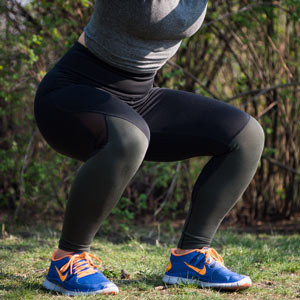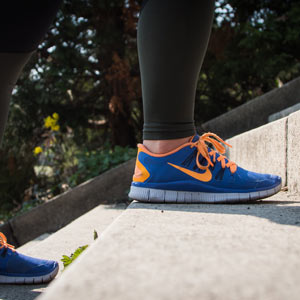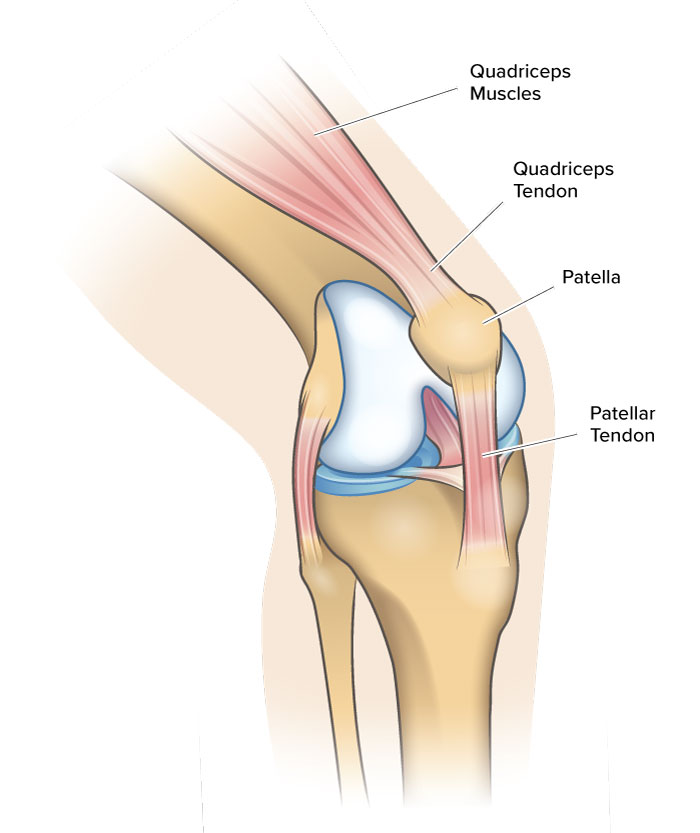Knee Pain When Bending and Squatting?

Do you have knee pain while bending, squatting, or kneeling? Read on for possible causes and solutions.
Climbing stairs to the office, squatting to tie your shoes, performing lunges at the gym, and kneeling while gardening. These are just several examples of simple activities that many of us perform daily. What do they have in common? They all require significant stability and mobility of the knee joint.
But what if your knee hurts during these actions? Knee pain when bending your joints can have a substantial negative impact on your quality of life. People with knee pain experience limited ability to live comfortably and complete everyday tasks.
The Cause of Knee Pain When Bending and Squatting


Chances are that your knee hurts only when it has to support your body weight and feels somewhat normal otherwise. This is because when you squat, your knee is subject to 6 to 8 times your body weight in pressure.1 Similarly, going up and downstairs, getting up from a chair, and kneeling all apply a high amount of force on your knee.
Tissue Trauma
Chances are you will likely know whether or not you have tissue trauma. These injuries are obvious because they usually have an immediate cause, like a fall. You will feel pain from these types of trauma suddenly. In addition, you will notice drastically limited knee function. The most common types of tissue trauma are MCL/ACL tears. Meniscus injuries and bone fractures are also common tissue traumas.
If your pain is the result of a fall or collision, you should seek expert medical attention immediately.
Overuse Injury
If you’re an athlete or work a physically demanding job your knee pain when bending could be the result of overuse. Repeating the exact same movement pattern without giving your body enough time for recovery can cause an overuse injury.
- Bursitis occurs when a knee bursa gets irritated from repetitive movement or constant direct pressure. The most commonly affected bursae are the prepatellar bursa and pes anserine bursa. Typically pain will increase when bending the knee under pressure and they will be visibly inflamed.
- Patellar Tendonitis occurs mainly in athletes who participate in jumping sports like basketball. A deep knee bend is typically very uncomfortable and pain may be worse in the morning.
- Patellofemoral pain syndrome typically occurs in more active individuals. Poor tracking of the knee cap as the knee is bending causes increased friction, which over time causes inflammation and pain.
The back of your knee cap is covered in articular cartilage. This soft viscous tissue allows the knee cap to move freely across the surface of the joint as you bend and straighten your knee. But in arthritic knees, some or all of this cartilage has eroded away leading to excessive friction and strain as the kneecap moves.
It’s estimated that over 50% of individuals with knee osteoarthritis have some degree of patellofemoral involvement causing pain specifically during movements that require a deep knee bend.2 If you are an older individual and think you may have osteoarthritis, take a look at our Guide to Severe Knee Arthritis.
What Should I Do About It?
Quadriceps Strength

A healthy knee joint is a collection of muscles working in harmony to produce movement. Unfortunately, specific muscles attached to your knee joint can sometimes become overdeveloped, while others lag behind and are relatively weaker. A weak VMO (vastus medialis oblique), for example, is often the cause of disorders like patellofemoral pain syndrome. Excessively tight lateral (outside) structures on the knee cause the knee cap to track outwards creating abnormal friction and knee pain.3
Research shows that people with stronger knees experience less arthritis pain with normal daily activities.4 Therefore, no matter your age, participating in strength training can help your knee health.
Ankle Flexibility
You can think of ankle “dorsiflexion” as your ability to pull your toes up towards your shin as far as possible. Flexible ankles are crucial in many common movements such as squatting, lunging, stair climbing, and running.
The normal range of motion during dorsiflexion is about 20 degrees. If your ankle can only move less than this, your body might begin compensating during movements that require a deep knee bend.5 The most common compensatory movements occur at the feet. For example, if you have stiff ankles, you may notice that your feet point outwards as you walk downstairs. This orientation is described as being pigeon-toed.
Another way your feet can compensate is by collapsing inwardly at their arches. This leads to what is called “knee valgus” or “knock knees”.6 This type of misalignment causes your knees to apply more pressure on the MCL, ACL, medial meniscus, and medial joint compartment. Over time, the extra pressure will wear away your cartilage. As a result, you might start experiencing pain during knee bends.
If you have tight ankles, there are several things you can do to solve or improve the issue.
- Stretch! You have two muscles that make up your calf: The Triceps Surae (upper calf) and the Soleus (lower calf). If these muscles get tight they will restrict your ability to move your ankle joint into dorsiflexion.
- Wear proper footwear. Modern running shoes have built-in heel lifts which can help make up for any deficits in ankle flexibility. Minimalist shoes with less cushioning and support can be great if you have healthy joints. However, if your knee is cranky, it’s best to wear something that makes up for any deficits in ankle flexibility.
Weight Loss
More body mass generally means more stress on your knee joint. If you perform activities that require you to regularly get into a deep bend, reducing your body mass could help ease your knee pain.
Rest & Modification
Sometimes rest is the best medicine. If your pain has been consistent for a long period of time, it may be worth talking with your employer or coach about a temporary reduction in the number of activities you participate in that irritate your knee. Once you have found some relief, it may be possible to slowly add these activities back in.
What’s Next?
- Learn more about knee pain, its causes, and solutions
- Learn more about treatment options for knee arthritis
- Visit your doctor or physiotherapist
References
- Dahlkvist, N. J., Mayo, P., & Seedhom, B. B. (1982). Forces during squatting and rising from a deep squat. Engineering in medicine, 11(2), 69-76.
- Duncan, R. C., Hay, E. M., Saklatvala, J., & Croft, P. R. (2006). Prevalence of radiographic osteoarthritis—it all depends on your point of view. Rheumatology, 45(6), 757-760.
- Dixit, Sameer, et al. “Management of patellofemoral pain syndrome.” Am Fam Physician75.2 (2007): 194-20
- Fujita, R., Matsui, Y., Harada, A., Takemura, M., Kondo, I., Nemoto, T., & Ota, S. (2014). Relationship between muscle strength and knee pain in knee osteoarthritis patients. Osteoarthritis and Cartilage, 22, S415.
- Neely, F. G. (1998). Biomechanical Risk Factors for Exercise-Related Lower Limb Injuries*. Sports Medicine, 26(6), 395–413.doi:10.2165/00007256-199826060-00003
- Schoenfeld, B. J. (2010). Squatting kinematics and kinetics and their application to exercise performance. The Journal of Strength & Conditioning Research, 24(12), 3497-3506.
Frequently Asked Questions
Knee pain during bending or squatting may be caused by tissue trauma or by an overuse injury.
An overuse injury is an injury caused by the repetition of certain movements over an extended period of time. Examples of overuse injuries in the knee include bursitis, patellar tendonitis, patellofemoral pain syndrome, and patellofemoral arthritis.
Strengthening muscles that are weaker compared to other muscles supporting the knee joint can increase knee joint stability and treat pain caused by overuse. Other treatments for overuse injuries include increasing ankle flexibility, rest and activity modification, and weight loss.